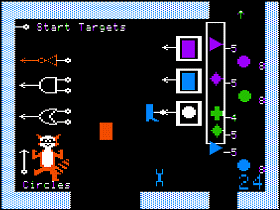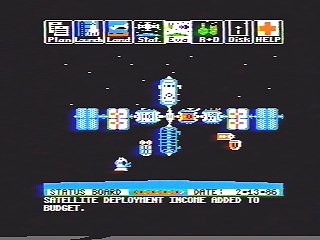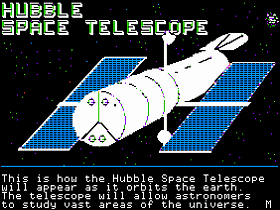Tranquility Base
 The Game: You are go for landing on the moon – only the moon isn’t there to make it easy for you. Craggy mountains and craters make it difficult for you to find one of the few safe landing spots on the surface, and even when you’re aligned above level ground, your fuel is running out fast. Do you have the right stuff that it’ll take before you can take one giant leap? (Bill Budge, 1981 / re-released by Eduware in 1984)
The Game: You are go for landing on the moon – only the moon isn’t there to make it easy for you. Craggy mountains and craters make it difficult for you to find one of the few safe landing spots on the surface, and even when you’re aligned above level ground, your fuel is running out fast. Do you have the right stuff that it’ll take before you can take one giant leap? (Bill Budge, 1981 / re-released by Eduware in 1984)
Memories: This game was one of the earliest efforts by a budding Apple II programmer named Bill Budge, before he achieved fame as the author of Pinball Construction Set. At the time, Budge was experimenting with interchangeable modules that could be slotted into the code of any number of games, including one for smoothly rotating 3-D wireframe objects – well, smoothly where the Apple II was concerned. The result was this unforgiving homage to Atari’s cult coin-op Lunar Lander. [read more]

 The Game: Rocky is trying to build machines to kick stuff. He provides players with a number of connectors and components, and shows them how they can be used to achieve different tasks. (The Learning Company, 1982)
The Game: Rocky is trying to build machines to kick stuff. He provides players with a number of connectors and components, and shows them how they can be used to achieve different tasks. (The Learning Company, 1982)

 The Game: You are the administrator of NASA. Your goal? To launch the necessary components of a full-scale space station, assemble them in orbit, and initiate and maintain any number of commercial or medical research projects aboard your orbital laboratory. You will also be in charge of launching satellites for commercial and military clients. As fun as all of these activities may sound, they don’t come without a price tag. The cost for everything from necessary space hardware, to time spent in the planning stages, to launches and landings, to maintaining the bare essentials of survival in orbit, will reach into the billions of dollars…if you’re good at this game. (HESware, 1985)
The Game: You are the administrator of NASA. Your goal? To launch the necessary components of a full-scale space station, assemble them in orbit, and initiate and maintain any number of commercial or medical research projects aboard your orbital laboratory. You will also be in charge of launching satellites for commercial and military clients. As fun as all of these activities may sound, they don’t come without a price tag. The cost for everything from necessary space hardware, to time spent in the planning stages, to launches and landings, to maintaining the bare essentials of survival in orbit, will reach into the billions of dollars…if you’re good at this game. (HESware, 1985) The Game: Your sleek spacecraft is launched from a base installation on Halley’s Comet (!). Your mission is to scout various bodies in the solar system – both planets and moons – which meet strictly defined criteria as dispensed by the computer. In some cases you must land, in others you must simply achieve orbit. You must learn to navigate the solar system using the constellations of the Zodiac, and learn to judge distance so you won’t overshoot your target (and therefore exceed your allotted mission time) with brief bursts of your faster-than- light drive. You climb in the ranks as you complete more missions. (Interscope, 1986)
The Game: Your sleek spacecraft is launched from a base installation on Halley’s Comet (!). Your mission is to scout various bodies in the solar system – both planets and moons – which meet strictly defined criteria as dispensed by the computer. In some cases you must land, in others you must simply achieve orbit. You must learn to navigate the solar system using the constellations of the Zodiac, and learn to judge distance so you won’t overshoot your target (and therefore exceed your allotted mission time) with brief bursts of your faster-than- light drive. You climb in the ranks as you complete more missions. (Interscope, 1986) The Game: Well, it’s not really a game. A NASA-published electronic press kit walks you through the basics of the then-upcoming
The Game: Well, it’s not really a game. A NASA-published electronic press kit walks you through the basics of the then-upcoming  The Game: Not a game, but a powerful (and free) space simulator, Celestia lets you pick what celestial bodies you observe, from any distance or close-up. You can tell Celestia to put convenient labels on any or all of the heavenly objects, or none of them, and even pick a minimum magnitude for background stars. But they’re not just wallpaper – you can click on and travel to any one of them, and you can follow them in a variety of ways. Add-on packages offer everything from updated imagery and orbital information for real planets, moons, comets and vehicles, as well as fictional add-ons for those who are feeling a bit fanciful. (Celestia Development Group, 2006)
The Game: Not a game, but a powerful (and free) space simulator, Celestia lets you pick what celestial bodies you observe, from any distance or close-up. You can tell Celestia to put convenient labels on any or all of the heavenly objects, or none of them, and even pick a minimum magnitude for background stars. But they’re not just wallpaper – you can click on and travel to any one of them, and you can follow them in a variety of ways. Add-on packages offer everything from updated imagery and orbital information for real planets, moons, comets and vehicles, as well as fictional add-ons for those who are feeling a bit fanciful. (Celestia Development Group, 2006)